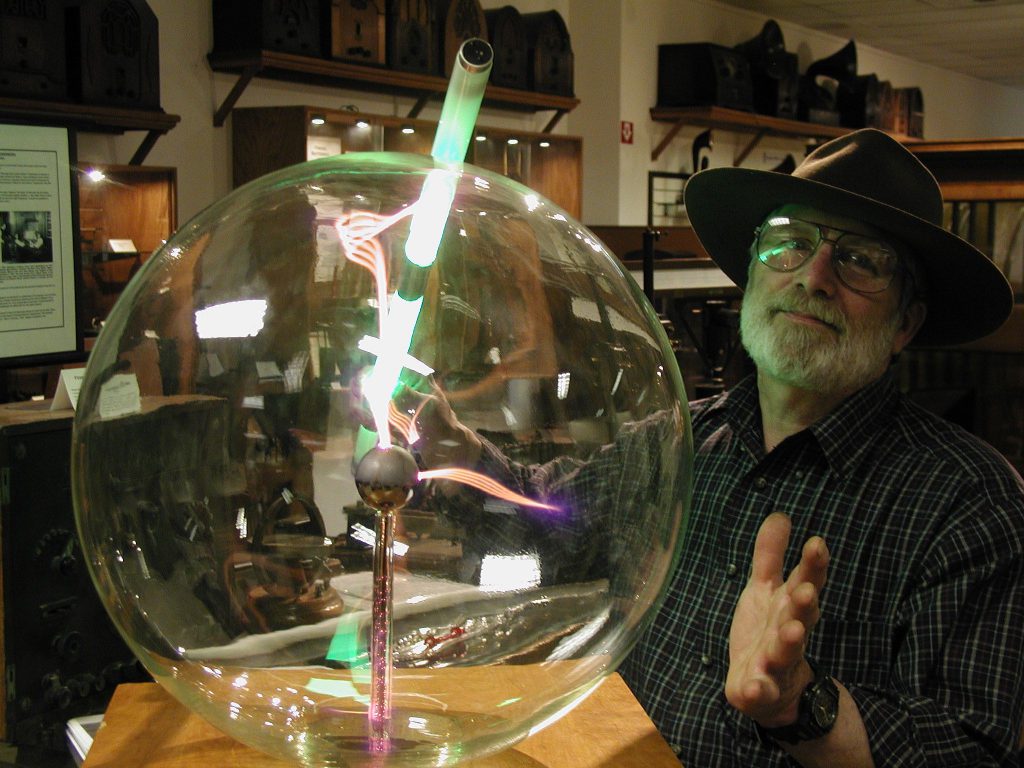People always tell us how fascinated they are with Nikola Tesla and his famous lightning machine: the Tesla coil. Visitors travel from all over the world to see our team of devoted electricians perform live demonstrations with a variety of these marvelous devices, including The MegaZapper, one of the largest Tesla coils in the country.

‘‘Loud, scary fun for the whole family! is what we advertise,” says John Jenkins, President & CEO. “Our Tesla coil demonstrations are often a big part of that experience.”
It’s no secret these spectacular machines, and the lightning they discharge, are dynamic, mesmerizing, and obviously quite dangerous—certainly not something most people would want to purchase for home entertainment.
Yet, we recommend you do consider getting one for your home or office. The type of Tesla coil we are talking about is infinitely entertaining, profoundly educational, and strikingly beautiful—especially in the dark, and best of all, it’s as safe to operate as a toaster oven.
The ‘plasma lamp’ or ‘lightning lamp’, was first invented in 1894 by physicist Nikola Tesla, as part of his research into high-frequency, high voltage electrical phenomena. Tesla called his invention an “inert gas discharge tube.”

The lamp is a partially evacuated glass sphere filled with a low-pressure inert gas. In the center of the sphere is an electrode (usually a metal rod with a knob on the end), connected to a power source.
The electrode generates a high-voltage, high-frequency electric field which ionizes the gas—emitting streams of bright plasma! The glass container allows us to see the discharge doing its frantic dance, as it reaches out searching for ground. The effect is instantly hypnotic, and always thought provoking.
Today’s modern plasma design was developed by research scientist James Falk, and MIT student Bill Parker in the early 1970s. They were able to formulate gas mixtures used in today’s plasma balls not available to Tesla. Modern globes typically use combinations of xenon, krypton, and neon, and other nobel gases. These gas mixtures, along with different glass shapes and integrated-circuit-driven electronics, create the vivid colors, range of motions, and complex patterns seen in today’s globes.

They became commercially popular in the 1980s, and a big hit with science classrooms and museums all over the world. In 1984, the award winning science writer, Jerry Pournelle, called his new globe “the most fabulous object in the entire world” and “magnificent … a new kind of art object”, stating “you can’t buy mine for any price”.
Some fun things to do with your little ball of lighting:
First, you get a light show! Put your plasma globe in an area where you can safely control the light. The darker the better—that’s why the Museum’s Performance Center has so many black curtains and covered windows: the darker the room, the more spectacular the spark.
You can touch the globe! That’s something you can’t normally do with a Tesla coil. When you touch the glass surface of the globe, your hand acts as a conductor, and the electrical current is attracted to your touch. It creates a path for the charged particles to follow, and you can see the colorful light streams gather towards your fingertips through your body and down to the floor. Bingo, the charge gets to ground via you!

Experiment with drawing shapes and patterns on the surface of the globe. You can create arcs, lines, or even sign your name. The plasma will follow the path of your touch and create fascinating designs. If two or more people touch the globe simultaneously, you may notice the streams of plasma interacting with each other. This can be a fun way to collaborate and create unique visual effects.
Broadcast energy! There are lots of ways to safely interact with a plasma globe, but remember, it is a Tesla coil, and it was created to broadcast electrical energy, without wires! If you carefully bring a florescent bulb or tube up to your plasma globe it will glow right in your hand, no wires. Like we said, infinitely fascinating.
These are just some of the many fun and educational demonstrations you can perform with a plasma globe. For more tips on this subject please visit: SPARK SciShort – Plasma.
Have fun, be safe, stay grounded.
